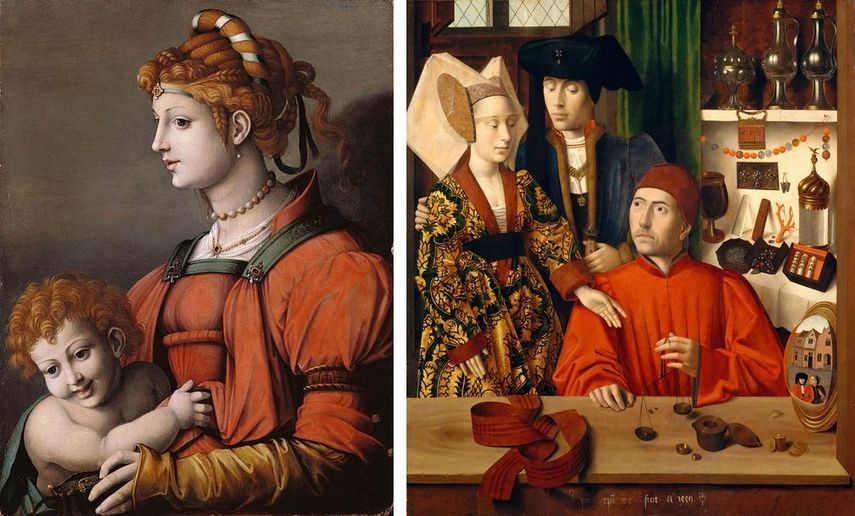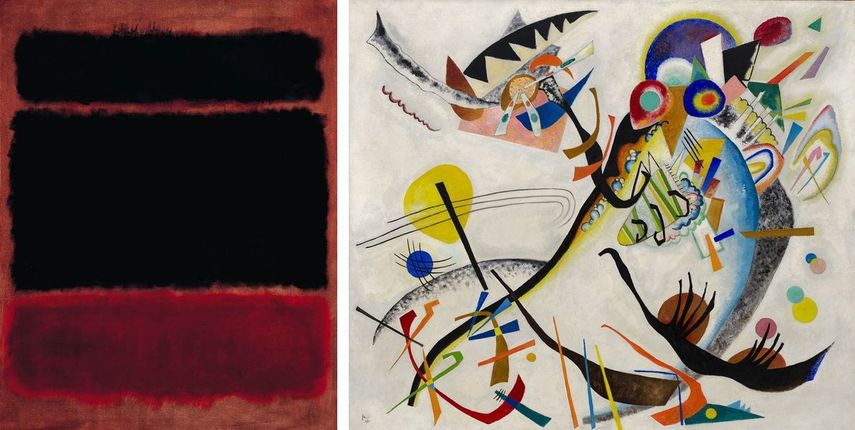Should Secular Art Have a Place in the Church
Upwards until the Renaissance, art was virtually exclusively informed by religious motifs. Yet, as the Italian Renaissance progressed, Western civilisation began to change drastically, assuasive for a certain type of secular fine art to sally. Artists and scholars were inspired to get back to the roots of the classical Greek and Roman societies equally a means of influencing a new culture. As the new idea of humanism became prevalent, giving ascension to a more secular guild, this caused a shift away from a traditional one in which the Church was dominant. Reflecting on this new society and its mores, the early on secular painting was crucial to the development of modern ideas of art. Thus, the emergence of the modern Western artwork is sometimes bandage as a slow procedure of secularization, with the devotional charge of images giving style in the fifteenth and sixteenth centuries to a focus on the beauty and innovation of the artwork itself. Merely what exactly is secular art? Scholars often dissimilarity the term with that of sacred or religious art. And then it seems that in order to understand secular art, nosotros need to define sacred art and its role first.

Sacred or Religious Art
The term sacred is commonly used in Western order in two ways. Firstly, sacred can refer to something that has been marked off for some religious purpose, whether being for a ritual or devotion. The second usage occurs amongst believers who conceive the term as the God himself, the absolute being or divine force. Recognized in vague human being terms as an indefinable feel of Being, it is referred to equally sacred or holy. Rudolph Otto, one of the most eminent scholars of religion, defined the feel of the Holy as the Wholly Other as simultaneously having a mysterium fascinans (attracting element) and a mysterium tremendum (awe-inspiring element). Thus, the sacred has a fascinating still awe-inspiring sense of mystery.[1]
Post-obit this definition of the sacred, sacred fine art refers to imagery that uses religious inspiration and motifs with an intent to uplift the mind to the spiritual. It should provide spiritual realization within the artist's religious tradition. Throughout the history of fine art, the function of sacred fine art has been to pb one to feel something of this mysterium. Besides beingness a representation of a saint or an illustration of a certain Bible story, sacred art should nowadays a window into the spiritual realm. Non perceived as a mere decoration, information technology should draw the viewer into an encounter with the holy. Beingness at once transcendent and down to earth, it is regarded that the work of sacred art should be apprehensive and practice not depict attention to itself since information technology serves a greater purpose.[2]

Defining Secular Art
Contrasted with the conception of the sacred, is that of the profane. The term comes from the Latin compound profanum, literally meaning before or outside the temple. Thus profane in its well-nigh general sense has meant that which is not holy, or that which does not pertain to a identify marked off or an object related to religious practice. The modern idea of fine art has its roots in the Italian Renaissance. Through the study of the art, poetry, philosophy, and science of aboriginal Greece and Rome, Renaissance humanists revived the notion that man, rather than God, is the measure out of all things. The dependence on the Church gave abroad to the confidence that humans can shape their own private destinies and the future of the world. As the guild was moving away from the authorisation of the church, Renaissance artists started turning towards the profane, depicting ordinary mundane scenes and objects. The Renaissance saw an increment in awe-inspiring secular works, but a secular, non-sectarian, universal notion of fine art arose in 19th century Western Europe. From the beginnings of recognizable avantgarde in the nineteenth century, art has been antithetical to religious observation. It was claimed that art possessed its ain intrinsic value and should not have to exist made to satisfy any edifying, utilitarian, or moral office.[3]
Thus, secular fine art can be divers equally art that has no religious reference points and is, in fact, oblivious to organized religion. Having an artful entreatment in a non-religious context, information technology neither denies or affirms the existence of God, but focuses on human agency. As Sartre wrote, " Indeed, everything is permissible if God does not exist, and as a result, the man is forlorn, because neither inside him nor without does he find anything to cling to." [4] However, even secular fine art can be deeply spiritual, but not in the religious sense. Various theorists have discussed how art, in general, has a certain spiritual prestige, an aura or indefinable magic.

Art and the Spiritual Experience
Fine art has a power unlike other human endeavors – it seems to open a door to a realm of ideas and emotions not accessible through any other route. A great deal of the experience of a painting is aesthetic and fifty-fifty intellectual – ane enjoys the structure of forms, textures and colors and you answer to the story, or ideas, or emotions the artist is eager to communicate. But also, the artwork is a site in which you are charmed past a peculiar artistic spell.[5] In short, fine art has a spiritual element. Spiritual is here defined not as a religious feel, but as the urge to transcend self or the present moment, to connect with the universe in some larger way. Thus, fine art viewing tin create an experience that can be divers by deep engagement or transcendence, empathy, awe or reverence or a land of wonder or resonance. The English philosopher R. G. Collingwood explained that the artist obtains catharsis from producing art. He extends this indicate by challenge that the creative person is oppressed past the unexplored, unexpressed emotion. Information technology is in the self-discovery of the experience through the called medium that the artist is freed from this oppression.[half dozen]
Many creatives speak about the relationship between their art and the spiritual. In 1910, the Russian painter Wassily Kandinsky published Concerning the Spiritual in Fine art. Here he explored the deepest and near authentic motives for making fine art, the internal necessity that impels artists to create equally a spiritual impulse and audiences to admire fine art as spiritual hunger.[vii] Marker Rothko, a gimmicky artist whose work promises depth and invites introspective reflection, was in search of an alternative language of spiritual expression to that offered past traditional religious imagery. In chat with the artist and art critic Selden Rodman, he explained: "I'm interested only in expressing basic man emotions: tragedy, ecstasy, doom, and and so on, and the fact that a lot of people break down and cry when confronted with my pictures shows that I communicate those basic man emotions... The people who weep before my pictures are having the same religious feel I had when I painted them. And if you, as you say, are moved but past their color relationships, then you miss the point!"[8] The German painter Gerhard Richter, a professed atheist, compared the experience of creating art to the religious search for God. In 1964, he wrote: "Art is non a substitute religion: it is a religion (in the true sense of the discussion: 'binding back', 'binding' to the unknowable, transcending reason, transcendent being). Only the church building is no longer adequate as a ways of affording experience of the transcendental, and of making religion real – and and so fine art has been transformed from a means into the sole provider of religion: which means religion itself." [9]
Exist sure to check out works past Kandinsky on our marketplace!
The American curator and critic Robert Storr stated that "a painting can help u.s. retrieve something that goes across this senseless existence". Indeed, art tin motion an audition to catharsis and clarify our emotional responses. The desire to create or await at art might be powered by the same eternal, spiritual need that drives one to the church building. It facilitates an run across with the presence of mystery in our lives and nurtures a relationship with it.

Editors' Tip: Concerning the Spiritual by Wassily Kandinsky
A pioneering work in the movement to free fine art from its traditional bonds to material reality, this book is 1 of the most important documents in the history of mod art. Written by the famous nonobjective painter Wassily Kandinsky (1866–1944), it explains Kandinsky's own theory of painting and crystallizes the ideas that were influencing many other mod artists of the period. Along with his own groundbreaking paintings, this book had a tremendous bear upon on the evolution of modern art. Kandinsky's ideas are presented in ii parts. The first part, chosen "About General Artful," issues a telephone call for a spiritual revolution in painting that will let artists express their own inner lives in abstract, non-material terms. In the second office, "About Painting," Kandinsky discusses the psychology of colors, the language of form and color, and the responsibilities of the artist. An Introduction by the translator, Michael T. H. Sadler, offers an additional caption of Kandinsky'due south art and theories, while a new Preface by Richard Stratton discusses Kandinsky's career as a whole and the affect of the volume.
References:
- Verostko, R. (1974) Religion & Art: the Sacred & the Profane. Verostko.
- Longnecker, D. (2016) The Office of Sacred Art. The Imaginative Conservative.
- Witcombe, C. Modernism. Art History Resources [Dec iii, 2016]
- Sartre, J. Existentialism and Humanism. Methuen Publishing Ltd, 2007
- Nelson, R. The Spirit of Secular Art: A History of the Sacramental Roots of Gimmicky Creative Values. Monash University Publishing, 2007
- Johnneal, T. (2013) The Relation betwixt Art & Emotion (Plato, Aristotle & Collingwood). Tim Johnneal
- Kandinsky, Due west. Apropos the Spiritual in Art. Dover Publications, 1977
- Crichton Miller, Eastward. (2012) At the chantry. Aeon.
- Crichton Miller, E. Ibid
Featured image: Wassily Kandinsky - Composition X, 1939, via ibiblio.com; Mark Rothko - Untitled, 1964, via markrothko.org. All images used for illustrative purposes but.
Source: https://www.widewalls.ch/magazine/secular-art
0 Response to "Should Secular Art Have a Place in the Church"
Post a Comment